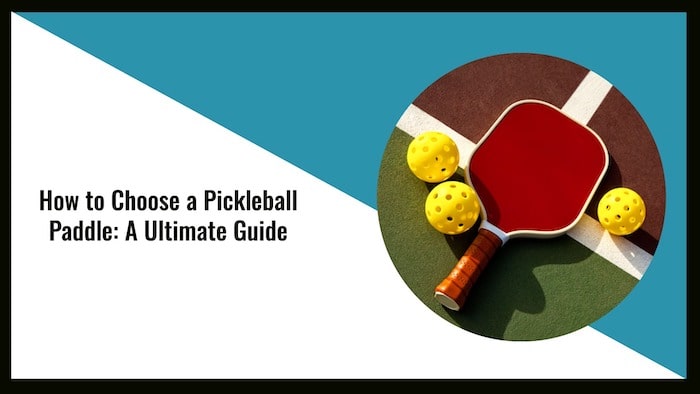Pickleball is a popular sport that has recently grown in popularity, attracting players of all ages and ability levels. The paddle is one of the most critical components of pickleball equipment. A decent pickleball paddle may help players improve their game and have a more enjoyable time playing.
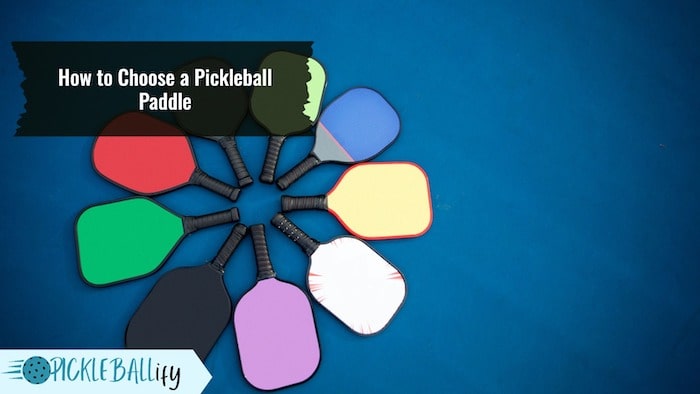
Nevertheless, with so many alternatives on the market, selecting the best pickleball paddle may be difficult. In this post, we will go through how to choose the best pickleball paddle for your playing style, skill level, and budget.
This guide will help you make an informed selection and choose the best pickleball paddle to help you flourish on the court, whether you’re a beginner or an experienced player.
Factors to Consider While Choosing a Pickleball Paddle
Weight, size, shape, material, grip, edge guard, and other aspects may all have an impact on your pickleball performance and comfort. Here are some of the most significant ones to think about:
Weight
The paddle’s weight can range from 6 to 14 ounces. Lighter paddles are often simpler to manoeuvre and put less strain on the arm and wrist, but heavier paddles give greater power and stability. The weight that is best for you is determined by your own preferences, playing style, and physical condition.
A good rule of thumb is to choose a weight that you can comfortably swing for a long time without fatigue or pain.
Size
The size of the paddle refers to the length and width of the hitting surface. The USAPA (USA Pickleball Association) sets the maximum size limit at 24 inches in total length. Within this limit, there are different sizes to suit different needs. You can check USAPA approved pickleball paddle here.
Larger paddles provide a larger surface area and sweet spot, which makes hitting the ball easier. Smaller paddles provide more control and manoeuvrability, particularly near the net. The ideal size for you is determined by your skill level, playing style, and personal preferences.
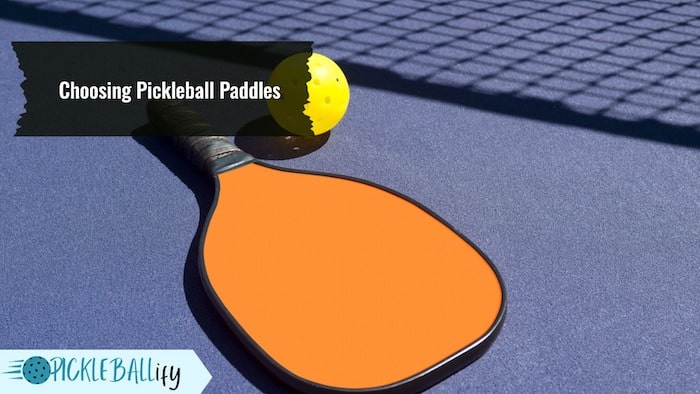
Shape
The shape of the paddle is related to the size and weight distribution. There are three common shapes: standard (rectangular), widebody (wider at the bottom) and elongated (longer at the top). Standard paddles are balanced and versatile, suitable for most players. Widebody paddles are more forgiving and offer more power at the baseline. Elongated paddles are more aerodynamic and offer more reach and spin.
Material
The material of the paddle affects its durability, weight, stiffness, and sound. There are three main types of materials: wood, composite, and graphite. Wood paddles are the cheapest and heaviest option, suitable for beginners or casual players.
Composite paddles are made of a core (usually honeycomb) covered by a fiberglass or carbon fiber face. They offer a good balance of power and control and come in various weights and sizes. Graphite paddles are similar to composite paddles but have a thinner and harder face made of graphite.
They offer more responsiveness and touch and are usually lighter and more expensive than composite paddles.
Grip
The grip is part of the paddle that you hold with your hand. It affects your comfort, control and accuracy when playing. The grip size is measured by the circumference of the handle. It should match your hand size so that you can hold the paddle firmly without squeezing too hard or losing control.
Wrap your fingers around the handle and look for a slight space between your fingers and palm to determine your grip size. If there is no space or there is too much gap, you may require a lower or bigger grip size. The distance between the bottom of the handle and the top of the paddle face is used to calculate grip length.
It should allow you to swing with appropriate leverage and wrist motion. A longer grip may be preferable for players who use two hands or desire more stability, while a shorter grip may be preferable for players who use one hand or prefer greater manoeuvrability. Typically, the grip material is a synthetic or leather wrap over a cushioned basis. It should provide your hand adequate friction and comfort without being overly harsh or slippery.
Edge Guard
The edge guard is a protective rim that covers the edge of the paddle face. It helps prevent damage to the paddle from hitting the ground or other objects. However, it also adds weight and reduces the hitting surface area of the paddle.
Some players prefer edgeless paddles that have no edge guard but have a tapered edge instead. These paddles offer more surface area and sweet spot but are more prone to chipping and cracking.
Types of Pickleball Paddles
Pickleball paddles are made of three different materials: wood, composite, and graphite.
Each variety has pros and cons based on your budget, skill level, and playing style. Below is a quick assessment of the benefits and drawbacks of each type:
1) Wood: Wooden paddles are the most traditional and least expensive alternative for pickleball players. They are strong and long-lasting and can tolerate heavy use. They are, however, the heaviest and least responsive alternative, making them difficult to manage and maneuver.
They also make a loud noise while hitting the ball, which may irritate certain players or venues. Wood paddles are ideal for novices who wish to try out the sport without spending too much money or for schools or groups with a significant number of players who want a large number of paddles.
2) Composite: For pickleball players, composite paddles are the most popular and adaptable alternative. They are constructed with a core (often honeycomb) and a façade of fiberglass or carbon fiber. They provide an excellent blend of power and control and are available in a variety of weights, sizes, and forms.
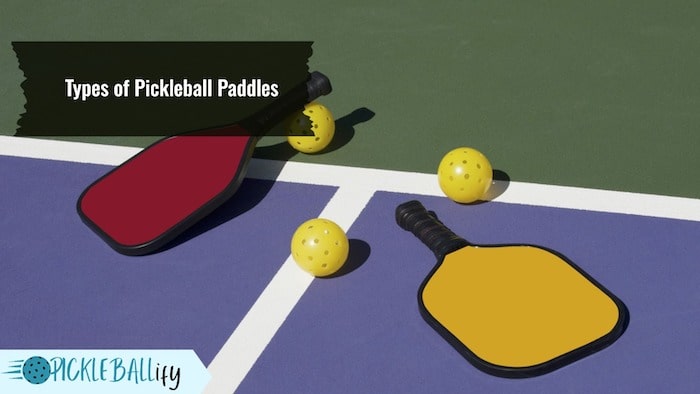
They also have a gentler sound than wood paddles, which some players or venues prefer. Composite paddles are ideal for intermediate to advanced players looking to enhance their game by using a high-quality paddle that matches their playing style and preferences.
3) Graphite: Graphite paddles are similar to composite paddles, but they have a thinner and harder graphite face. They provide more responsiveness and feel but are typically heavier and more expensive than composite paddles.
While hitting the ball, they also make a clear sound, which may appeal to particular players or settings. Advanced players who want to improve their performance with a quality paddle that may give them with more speed and precision should choose graphite paddles.
How to Test a Pickleball Paddle
Before buying a pickleball paddle, it is important to test it out and see if it suits your needs and preferences. Here are some tips on how to test a pickleball paddle:
- Swing Speed: Swing the paddle back and forth like you’re hitting the ball while holding it in your hand. Consider how quickly or slowly you can swing the paddle without sacrificing comfort or control. A heavier paddle will give you greater power but may slow down your swing, whilst a lighter paddle will let you swing more quickly.
- Balance: Feel the weight distribution while holding the paddle in your hand. Even weight distribution across a balanced paddle makes it simple to handle and maneuver. A head-heavy paddle will be heavier at the top, increasing power but decreasing stability. A head-light paddle will be heavier towards the bottom, making it more agile but less powerful.
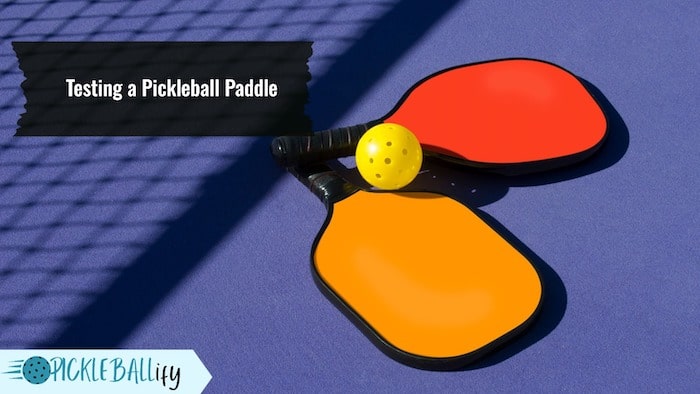
- Comfort: Feel how comfortable it feels to grasp and swing the paddle in your hand. The grip size should correspond to the size of your hand so that you can grasp the paddle securely without squeezing too tight or losing control.
While swinging, the grip length should allow you to have appropriate leverage and wrist motion. The grip material should be rough and slippery enough to give appropriate friction and comfort for your hand. The edge guard should not interfere with your striking surface and should not be uncomfortable.
- Sound: Listen to the sound the ball makes when you hit it with the paddle. The sound of the paddle may have an impact on both your pleasure in the game and your acceptance of the location where you play.
Some paddles generate a loud sound that some players or venues may find unpleasant, while others produce a gentler sound that certain players or venues may like.
FAQs
The appropriate pickleball paddle can help you improve your court play and overall enjoyment. It can also help to avoid injuries and exhaustion caused by using the incorrect paddle.
Yes, your skill level should be a factor in choosing a paddle. Beginner players may benefit from a larger hitting surface and a lighter paddle, while more experienced players may prefer a smaller hitting surface and a heavier paddle for more power and control.
The ideal weight for a pickleball paddle depends on your preferences and playing style. Generally, paddle weights range from 6-14 ounces, with most players finding a weight between 7-9 ounces to be comfortable.
Yes, grip size is important for comfort and control. A paddle with the wrong grip size can lead to discomfort, fatigue, and decreased performance on the court.
Final Words
Choosing the right pickleball paddle is a crucial step in enhancing your game and overall experience on the court. By considering factors such as weight, grip size, material, shape, and playing style, you can select a paddle that feels comfortable and meets your specific needs.
It’s also important to keep in mind any regulations for tournaments if you plan to participate in them. Whether you’re a beginner or an experienced player, taking the time to choose the right pickleball paddle can make a significant difference in your performance and enjoyment of the sport.
We hope this guide has been helpful in providing you with the knowledge and tips to make an informed decision and find the perfect pickleball paddle for you.

